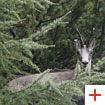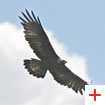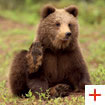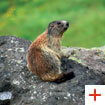
The large variety of environments contained within the territory of the Dolomites UNESCO World Heritage Site has allowed the settlement of numerous animal species, some of which have eventually adapted to very extreme habitats. Perhaps, that is one of the aspects which continue to attract researchers and enthusiasts and which have always seduced tourists and nature lovers.

The fauna of the Dolomites comprises several well-known animals you can easily sight, such as the squirrel and the roe deer, but it also includes numerous still unknown species, especially among the invertebrates. The
bird fauna is well represented by the golden eagle, the grouse

and the white partridge, mostly living in the territory of the Dolomiti Bellunesi National Park, the Dolomiti di Sesto National Park, the Adamello-Brenta Natural Park and the Puez-Odle Natural Park. The Dolomiti Bellunesi National Park in particular hosts 115 species of nesting birds, and among them are eight couples of golden eagles. Among the
nocturnal birds of prey stand out the pygmy owl and the boreal owl, distributed in the Ampezzano area and in the Adamello-Brenta property.

The group of the
plantigrades comprises the brown bear (which, like the lynx, returned spontaneously to this lands following the environmental improvement of some areas; it was recently sighted in the Cadore zone in the province of Belluno), whereas in the group of the ungulates there is the chamois (which populates the prairies of Sesto, the Vallunga and the Odle of Funes, but mostly the Ampezzo Dolomites), the roe deer, the deer, the ibex and the mouflon. The squirrel and, even more, the marmot are among the most represented
rodents on almost all the systems of the Dolomites UNESCO World Heritage Site: from the nature parks of the Bellunese area to the nature reserve Fanes-Sennes-Braies.

In several areas of the Dolomites you can also meet badgers, martens, ermines and hares, which all belong to the weasel family. Within the cooler woodlands and in the low-altitude wetlands you can easily sight amphibians like the fire salamander, with its distinctive black with yellow spots coloring, and the Alpine newt. In contrast, on more sunny reserves you can easily meet some feared reptiles like the Asp viper and the common adder.
 The large variety of environments contained within the territory of the Dolomites UNESCO World Heritage Site has allowed the settlement of numerous animal species, some of which have eventually adapted to very extreme habitats. Perhaps, that is one of the aspects which continue to attract researchers and enthusiasts and which have always seduced tourists and nature lovers.
The large variety of environments contained within the territory of the Dolomites UNESCO World Heritage Site has allowed the settlement of numerous animal species, some of which have eventually adapted to very extreme habitats. Perhaps, that is one of the aspects which continue to attract researchers and enthusiasts and which have always seduced tourists and nature lovers. The fauna of the Dolomites comprises several well-known animals you can easily sight, such as the squirrel and the roe deer, but it also includes numerous still unknown species, especially among the invertebrates. The bird fauna is well represented by the golden eagle, the grouse
The fauna of the Dolomites comprises several well-known animals you can easily sight, such as the squirrel and the roe deer, but it also includes numerous still unknown species, especially among the invertebrates. The bird fauna is well represented by the golden eagle, the grouse  The group of the plantigrades comprises the brown bear (which, like the lynx, returned spontaneously to this lands following the environmental improvement of some areas; it was recently sighted in the Cadore zone in the province of Belluno), whereas in the group of the ungulates there is the chamois (which populates the prairies of Sesto, the Vallunga and the Odle of Funes, but mostly the Ampezzo Dolomites), the roe deer, the deer, the ibex and the mouflon. The squirrel and, even more, the marmot are among the most represented rodents on almost all the systems of the Dolomites UNESCO World Heritage Site: from the nature parks of the Bellunese area to the nature reserve Fanes-Sennes-Braies.
The group of the plantigrades comprises the brown bear (which, like the lynx, returned spontaneously to this lands following the environmental improvement of some areas; it was recently sighted in the Cadore zone in the province of Belluno), whereas in the group of the ungulates there is the chamois (which populates the prairies of Sesto, the Vallunga and the Odle of Funes, but mostly the Ampezzo Dolomites), the roe deer, the deer, the ibex and the mouflon. The squirrel and, even more, the marmot are among the most represented rodents on almost all the systems of the Dolomites UNESCO World Heritage Site: from the nature parks of the Bellunese area to the nature reserve Fanes-Sennes-Braies. In several areas of the Dolomites you can also meet badgers, martens, ermines and hares, which all belong to the weasel family. Within the cooler woodlands and in the low-altitude wetlands you can easily sight amphibians like the fire salamander, with its distinctive black with yellow spots coloring, and the Alpine newt. In contrast, on more sunny reserves you can easily meet some feared reptiles like the Asp viper and the common adder.
In several areas of the Dolomites you can also meet badgers, martens, ermines and hares, which all belong to the weasel family. Within the cooler woodlands and in the low-altitude wetlands you can easily sight amphibians like the fire salamander, with its distinctive black with yellow spots coloring, and the Alpine newt. In contrast, on more sunny reserves you can easily meet some feared reptiles like the Asp viper and the common adder.
Comments
Post a Comment